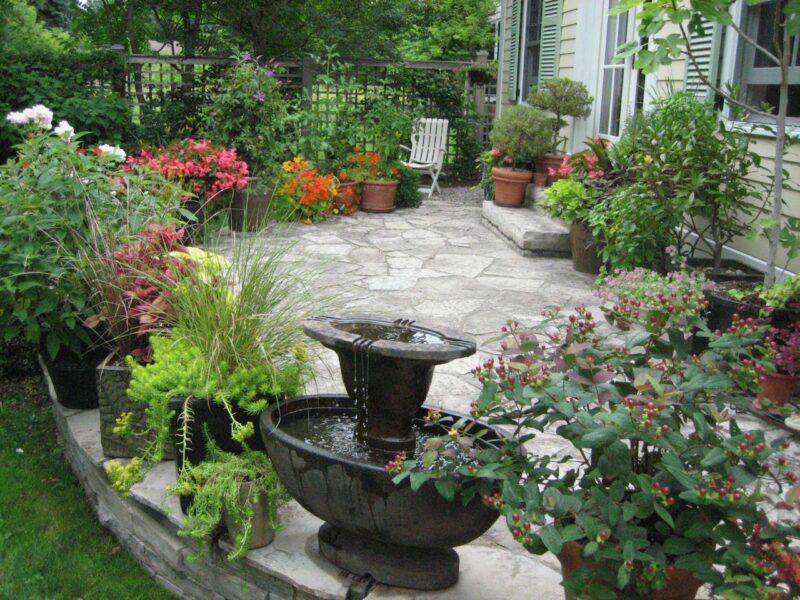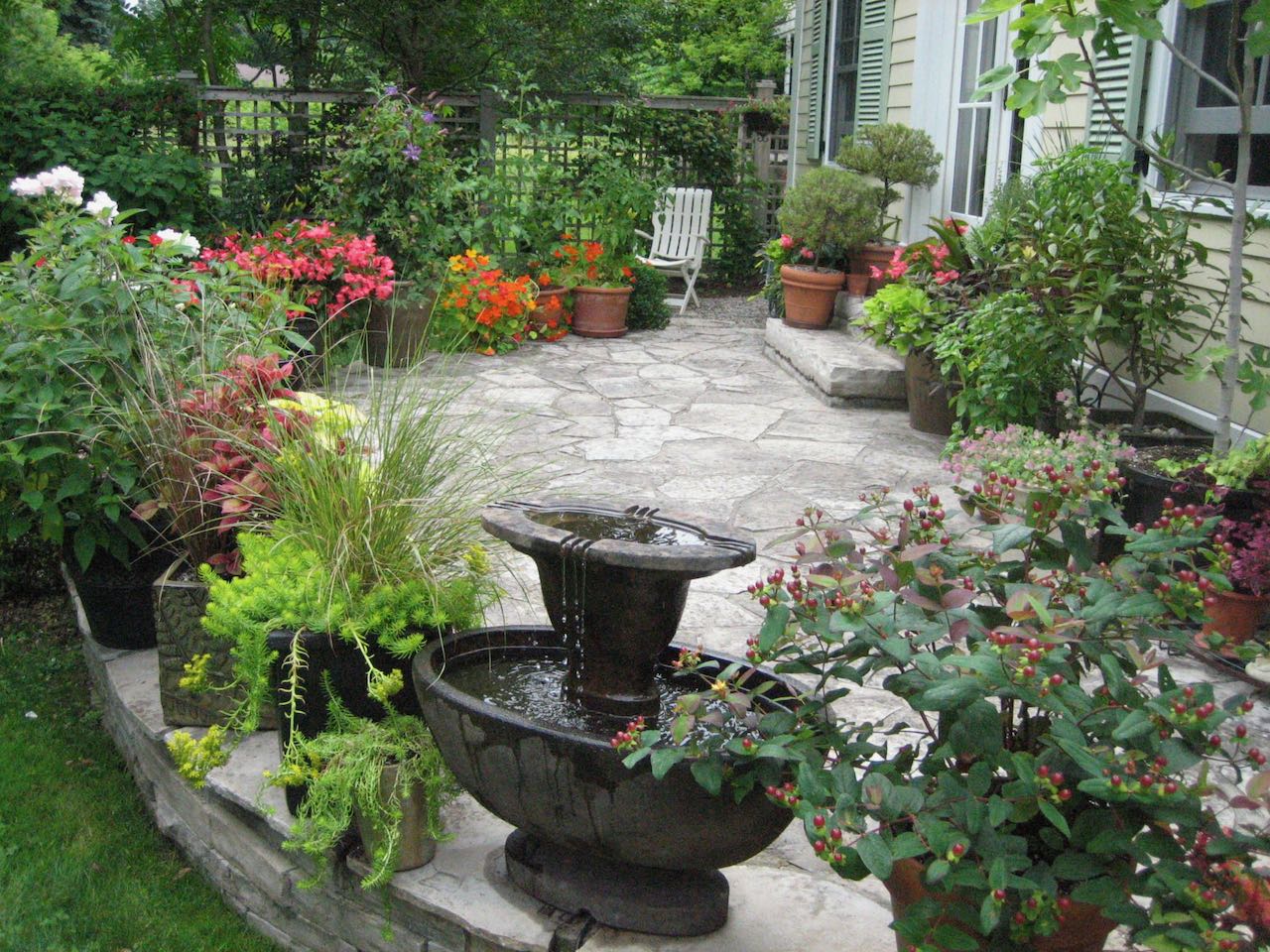
You can enjoy gorgeous pots with your container gardening. Here’s a list with 6 container gardening tips from Garden Making Editor-in-Chief Beckie Fox:
1. Choosing Your Container
• Choose containers in shapes and styles compatible with your house and landscape. Terra cotta, concrete and cast-iron are beautiful but heavy. Plastic is inexpensive and light, but not always aesthetically pleasing. Wood provides good insulation and can be painted to match house trim. Baskets lined with moss or plastic are charming and work well with colourful spring plants. Choices are endless—use your imagination!
• The bigger the pot, the less watering required and the more possibilities for different plant combinations. Large containers provide more visual impact, too. • All containers need adequate drainage. Do not use potshards or gravel to cover drainage holes. Cut squares of window screening to place over the holes or leave them open. This allows excess water to easily drain away—soggy plants are unhappy plants!
2. Start with the Right Soil
• Container soil needs to be clean (free of diseases, weeds and insects), loose and airy, and able to retain water, yet free draining. For these reasons, packaged container soil or potting soil—not garden soil—is recommended. • Most commercial products are a mixture of pasteurized topsoil, peat moss, coarse sand, vermiculite and/or perlite. Read labels to see if your mixture already includes fertilizer or wetting agents before adding your own. Some packaged potting soils are too heavy for container growing. Add some soilless mix to make it lighter and fluffier. • Always moisten container mix thoroughly before filling a container for planting. Hint: it’s easier to moisten these peat-based mixes with warm water than with cold.
3. Water & Food = Happy & Healthy Plants
• Use a transplanter solution (high in phosphorus + indolu butylic acid to aid root formation) after planting; don’t fertilize again until you notice new growth. Then, feed every 10 to 14 days with a balanced (10-10-10 or 15-15-15, for example) water-soluble fertilizer diluted to at least half strength or more. The key is giving your containers small doses of food frequently, not heavy meals infrequently.
• Don’t fertilize when the soil is dry; water a few hours or a day ahead before feeding.
• Assess each pot and decide if it needs water. When the top couple inches of soil are dry, it’s time for a drink. Make sure the soil is moist from the top all the way to the bottom and any excess water is able to drain away.
• There is no pattern, no routine, for watering. Smaller containers in full sun need more frequent watering than a large container in shade. Small transplants at the beginning of the season won’t need as frequent watering as later in the season when they are mature and their roots have filled the soil mix.
• Quick diagnostics: Signs of overwatering or poor drainage include wilted, limp leaves; mouldy flowers or buds; brown leaf tips; young and old leaves drop off; brown, mushy roots; yellow bottom leaves. Signs of underwatering include wilted, limp leaves; flowers that fade soon after blooming; brown, dry edges on lower leaves; older, lower leaves drop off.
4. Combining Plants with Confidence
Here are some basic design principles — and practical issues — to consider when creating a mixed container:
• Choose plants with similar requirements—shade or sun, drought-tolerant or consistent moisture.
• Decide on your accent or focal point plant before selecting filler and trailing plants to complement it.
• Know where the container will be viewed from. If it will be seen from afar, go for bold, dramatic foliage and flowers. If it will be viewed up close, the details of smaller flowers and intricate foliage will be better appreciated.
• If colour combos baffle you, select one colour and use various intensities of it.
• Consider the shape of your container. If it’s wide and low, choose plants that are low and spreading. To accent the lines of a narrow, tall container, include a few tall narrow plants in the mix.
•Don’t forget to contrast the colour, shape and texture of foliage, too.
• Sometimes less is more. Too many different plants in one container often looks busy and chaotic.
• Always plant fully—pack in the plants! Now is not the time to skimp and wait for plants to “fill in.” The aim is to have a lush, generous look from the start. Careful watering, feeding, deadheading and good soil will help plants thrive in their confined locations.
5. A Few More Design Tips
• Experiment in the nursery by placing plants together to see how they look.
• If you’re still unsure if you want to tackle a container using several types of plants, choose three or four various-sized containers and plant one type of plant per container. Cluster the containers together for a miniature floral garden.
• Take inspiration from floral arranging, interior design and fashion. If you like a dress that’s hot pink with orange and white trim, chances are a container brimming with lots of hot pink geraniums, a few orange lantana and white bacopa will be pretty, too.
6. Most Important of All
Have fun! Container gardening is a great way to experiment with different plant and colour combinations. Let your inner artist escape!


Hi Beckie
I am a long time gardener who looks at a LOT of gardening sites. I find your information so refreshing. Nitty-gritty information that is right to the point. I get so tired of the light on real information, high on promotion predictables offered on so many sites. This one on container growing was especially timely and useful as that is a weak spot for me. I am certainly looking forward to more of your quality writing and information. And thank you!
Thank you for your kind comments. My weakness is definitely container growing, too.
I have planted my dahlias in containers for a few years now. They tend to bloom almost all summer and into fall. I don’t baby them with anything special (I do use a home-composted mix of soil) and make sure to deadhead the spent blooms frequently. Pull them out in fall, store the tubers and plant again in spring! Good luck!
Margaret (May 5)
Dahlias are good plants for container growing! One summer I grew them in pots and they were lovely, and it was nice to have the flowers elevated and closer for view. Select a container large enough to allow the tubers to expand. A heavy clay pot is a good choice (lined with plastic, and a hole cut in the bottom for drainage); it helps to balance the plant and prevent tipping. For a growing medium, try a 50/50 mix of peat-based soilless mix and a heavier potting soil to provide good anchorage for the tubers. Feed every three weeks using a fertilizer with a higher middle number (phosphorus), to encourage flower bud formation. Look for an analysis like 5-10-5 or 10-15-10, or anything similar. Depending on the size of dahlias you grow, you may need to stake them in their pots. Good luck, and you’re going to love these dahlias!
Thanks for the container gardening tips. I would like some advice on growing dahlias in containers.
Thank you.
Thank you. I enjoy getting these tips to help with my gardening.